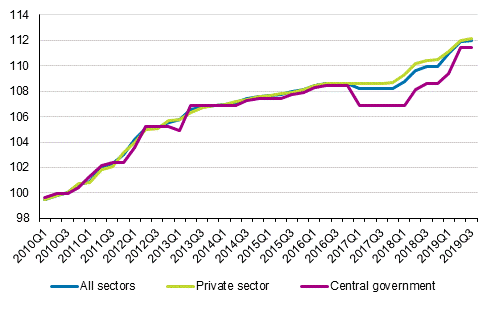Published: 15 October 2019
Index of wage and salary earnings rose by 2.4 percent in July-September
According to preliminary data of Statistics Finland, the nominal earnings of wage and salary earners rose by 2.4 per cent in July to September 2019 when compared with the respective period in 2018. Real earnings rose by 1.4 per cent compared to the third quarter of the previous year, because the rise in earnings level was faster than that in consumer prices.
Index of wage and salary earnings and real earnings 2000/1 to 2019/3, annual change percentage

According to Statistics Finland’s preliminary data, the nominal earnings of wage and salary earners rose from July to September 2018 to the corresponding period in 2019 by 2.1 per cent in the private sector, by 3.2 per cent in the central government sector and by 3.4 per cent in the local government sector.
Wage and salary earners’ regular earnings increased by 2.2 per cent in July to September
The index for regular earnings describes the permanent change in earnings better than the index of wage and salary earnings because it does not take into account performance-based bonuses and non-recurring items included in collective agreements. Regular earnings rose by 2.2 per cent in July to September 2019 when compared with the respective period in 2018. The growth amounted to 2.1 per cent in the private sector, to 2.4 per cent in the central government sector, and to 2.6 per cent in the local government sector.
Contractual pay increases occurred in the first half of the year in the public sector
The figure examines the development of the index of negotiated wages and salaries 2010=100 in 2010 to 2019. Employer sectors total, private sector and central government sector were selected to the examination. In the central government sector, the development of the index of negotiated wages and salaries has in recent years largely followed the development of the index of negotiated wages and salaries in the local government sector. In the central government sector, the index of negotiated wages and salaries fell in the first quarter of 2017, because the reduction in public sector holiday bonuses agreed on in the Competitiveness Pact is also visible in the development of the index of negotiated wages and salaries. In 2017, the index of negotiated wages and salaries remained unchanged and turned upwards in the second quarter of 2018. The rise continued in the beginning of 2019, when a non-recurring item based on profitability was paid in the central government sector. It amounted to 9.2 per cent of the monthly pay of those entitled to the non-recurring item. Furthermore, wages and salaries rose in the central government sector due to an overall increase and agency-specific item in April 2019.
Development of the index of negotiated wages and salaries 2010=100 by employer sector

The index of negotiated wages and salaries in the private sector remained unchanged in 2017, when there were, in practice, no contractual pay increases. The index turned upwards in the first quarter of 2018 and continued rising in 2019. In the private sector, the times for pay rises vary by collective agreement sector and therefore the rise in the index of negotiated wages and salaries is more even during the year. However, in the recent years, the rise in the private sector has also centred around the early part of the year.
Index of wage and salary earnings and index of regular earnings are final as far as the year 2018
The indices of wage and salary earnings and the indices for regular earnings are final until 2018. They are based on the realised earnings development. The indices for 2019 are preliminary and they are based on estimates of agreement effects and the wage drift. In addition, the data on performance-based bonuses of the Labour Cost Index are used to assess performance-based bonuses in the calculation of the preliminary indices of the index of wage and salary earning.
Source: Index of wage and salary earnings 2019, 3rd quarter. Statistics Finland
Inquiries: Anu Uuttu 029 551 2322, Harri Nummila 029 551 3235, palkat.indeksit@stat.fi
Director in charge: Mari Ylä-Jarkko
Publication in pdf-format (454.5 kB)
- Tables
-
Tables in databases
Pick the data you need into tables, view the data as graphs, or download the data for your use.
Appendix tables
- Appendix table 1. Index of wage and salary earnings 2015=100 by employer sector and base of payment (15.10.2019)
- Appendix table 2. Index of regular earnings 2015=100 by employer sector and base of payment (15.10.2019)
- Appendix table 3. Index of wage and salary earnings 2015=100 by employer sector and gender (15.10.2019)
- Appendix table 4. Index of regular earnings 2015=100 by employer sector and gender (15.10.2019)
- Appendix table 5. Index of wage and salary earnings 2015=100 by industry, (TOL 2008) (15.10.2019)
- Appendix table 6. Index of regular earnings 2015=100 by industry, (TOL 2008) (15.10.2019)
- Appendix table 7. Index of wage and salary earnings 2010=100 by employer sector and gender (15.10.2019)
- Appendix table 8. Index of wage and salary earnings 2010=100 by industry, (TOL 2008) (15.10.2019)
- Appendix table 9. Index of wage and salary earnings 2015=100, percentage changes (15.10.2019)
- Appendix table 10. Index of regular earnings 2015=100, percentage changes (15.10.2019)
- Appendix table 11. Average earnings by employer sector and gender, EUR/month (15.10.2019)
- Revisions in these statistics
-
- Revisions in these statistics (15.10.2019)
Updated 15.10.2019
Official Statistics of Finland (OSF):
Index of wage and salary earnings [e-publication].
ISSN=1798-7814. 3rd quarter 2019. Helsinki: Statistics Finland [referred: 7.1.2026].
Access method: http://stat.fi/til/ati/2019/03/ati_2019_03_2019-10-15_tie_001_en.html

